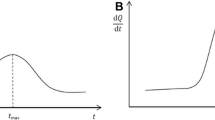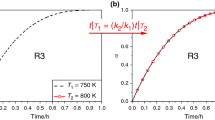Abstract
The cyclic and Controlled Rate Thermal Analysis method (CRTA) has been used. The two rates automatically selected in the cyclic curve are small enough to allow the two states of the sample to be compared have nearly the same reacted fraction. Thus, the activation energy can be calculated without previous knowledge of the actual reaction mechanism.
Provided that the activation energy,E, is known, a procedure has been developed for determining the kinetic law obeyed by the reaction by means of master curves that represent the values of the reacted fraction, α, as a function of−E/R(1/T-1/T 0.5),T 0.5 being the temperature at which α=0.5. This procedure has been tested by studying the thermal decomposition reaction of BaCO3.
Zusammenfassung
Cyclische und Controlled Rate Thermal Analysis (CRTA) wurde verwendet. Die in der cyclischen Kurve automatisch gesetzten zwei Geschwindigkeiten sind klein genug, um zuzulassen, daß die beiden zu vergleichenden Proben annähernd die gleiche umgesetzte Fraktion zu beinhalten. Somit kann die Aktivierungsenergie ohne vorheriges Wissen des jeweiligen Reaktionsmechanismus berechnet werden. Für den Fall, daß die AktivierungsenergieE bekannt ist, wurde mit Hilfe von Master-Kurven, welche die Werte für die bereits reagierte Fraktion als Funktion von−E/R(1/T-1/T 0.5) darstellen, ein Verfahren zur Bestimmung des Geschwindigkeitsgesetzes entwickelt, dem die Reaktion unterliegt (bei der TemperaturT 0.5 ist α=0.5). Dieses Verfahren wurde an der Untersuchung der thermischen Zersetzungsreaktion von BaCO3 getestet.
Similar content being viewed by others
References
J. M. Criado, A. Ortega and F. J. Gotor, Thermochim. Acta, 157 (1990) 171.
J. M. Criado and J. Morales, Thermochim. Acta, 19 (1977) 305.
J. Male, J. esták, F. Rouquerol, J. Rouquerol, J. M. Criado and A. Ortega, J. Thermal Anal., 38 (1992) 71.
J. M. Criado, Thermochim. Acta, 28 (1979) 307.
F. Rouquerol, S. Regnier and J. Rouquerol, ‘Thermal Analysis’ (I. Buzás (Ed.), Heyden, London 1975, p. 313.
S. Bordere, A. Floreancing, F. Rouquerol and J. Rouquerol, Solid State Ionics, 63–65 (1993) 229.
J. M. Criado, F. Rouquerol and J. Rouquerol, Thermochim. Acta, 38 (1980) 117.
Author information
Authors and Affiliations
Rights and permissions
About this article
Cite this article
Criado, J.M., Perez-Maqueda, L.A. & Ortega, A. Development of master curves for discriminating the mechanism of solid state reactions from experimental data obtained by using the cyclic and controlled rate thermal analysis. Journal of Thermal Analysis 41, 1535–1541 (1994). https://doi.org/10.1007/BF02549951
Issue Date:
DOI: https://doi.org/10.1007/BF02549951




